Ancient Greece had a direct and a personal relation with the religion and religious beliefs. The rituals, ceremonies, daily activities, beliefs, festivals, and even the cities had influence of the religion.
The temples and sanctuaries had an immense affect on the daily life of the Greeks. Likewise, myths about the deities played a vital role in daily life functioning. The acts, mostly good deeds and bad deeds were considered to have a consequence in after life.
Majorly, Ancient Greek religion refers to rites, myths, beliefs, and culture that originated in ancient Greece and were practiced as religion and cults. But, they had not chosen any name or title for religion, and the closest term for it was either threskeia or eusebeia.
Though the two are closely related, Greek religion is distinct from Greek mythology, which is concerned with traditional legends.
Its influence reached as far west as Spain, east as the Indus River, and across the Mediterranean.
The belief in a plurality of anthropomorphic deities under one supreme God was the most remarkable feature of Greek religion.
Priests were only responsible for cults; they were not clergy, and there was no sacred literature.
The Greeks’ only needs were to believe in the gods and to undertake rituals and sacrifices for the gods to receive their due.
It was dangerous to reject the presence of a deity for fear of retaliation from the deity or other mortals.
The 12 Olympian deities were recognized by most ancient Greeks: Ares, Zeus, Poseidon, Hera, Athena, Aphrodite, Artemis, Demeter, Hermes, Apollo, Hestia, and Hephaestus.
They were worshipped across Ancient Greece, sometimes with other names depending on another local deity’s features, association, and absorption.
Greek religion impacted numerous other religions, including Etruscans and Roman religion, for having Italian faiths.
What purpose did the oracles serve in ancient Greek religion?
Content
Oracles were sites where people might get their fortunes told. Prophecies were messages from the gods that predicted what would happen.
What is a characteristic of ancient Greek and Roman religion?
Greek and Roman religions are comparable because they are polytheistic religions- the belief in or worship of several gods or divinities.
Furthermore, despite the changes in names, the gods of the Greeks and Romans were nearly identical.
What is ancient Greek religion called?
Despite being a religious Empire, Ancient Greece did not have any particular term for religion.
However, the closest term for it was eusebeia and threskeia, meaning cult.
Theology: Nature of Gods in ancient Greek and their religious beliefs
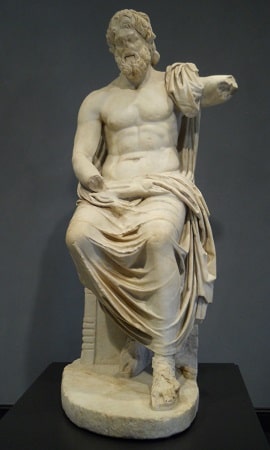
Ancient Greeks had faith and belief in numerous deities and supernatural beings. Their religion was considered Polytheistic like many other Empire’s religion.
Greek God Zeus was the King of the Greek Gods who controlled all other deities, thunder, and lightning. He was also considered the Sky God in Greek Religion.
Likewise, another god, Poseidon was in charge of earthquakes and sea, and Hades was in charge of the underworld and the realms of death.
All prominent deities were depicted as human in appearance, despite their ability to turn into animals or natural occurrences.
Also, they had a human-like nature in some cases, despite them being immortal and powerful. As per the Greek mythology, these deities had to face their fate of Moirai that overrode their wills and supernatural powers.
For example, during the Trojan War, the journey of Odysseus was made longer and more difficult by the deities but they could not stop him while he was returning to Ithaca.
The deities would also have emotions and feelings like the humans. They would live amongst them, bear children with the humans, and have interactions with them.
Similary, these deities were linked to particular cities and towns, based on their associations. For instance, god Zeus was linked with Olympia, Athena with city of Athens, Apollo with Delphi, and Aphrodite with Corinth.
Some deities were linked with nations located outside Greece, for instance, Ares was linked to Thrace, and Poseidon with Troy or Ethiopia.
Afterlife: Ancient Greek beliefs of Life after death
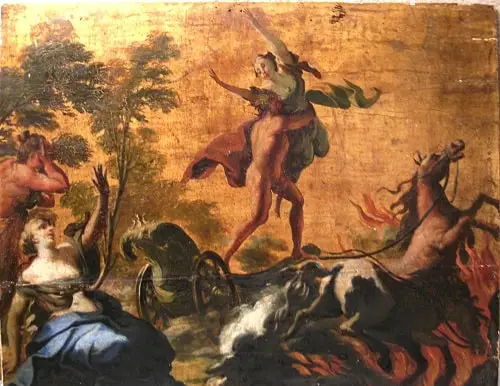
The Greeks believed that after death, the dead spirits journeyed to an underworld. Hades, the deity of the underworld, was the in charge of that underworld.
The two famous underworld are Elysium and Tartarus. They are associated with the land of joy and punishment, respectively.
Though, initially, all the deceased went to the underworld of Hades, with time and increased mystery cults during the Archaic period, the deceased also went to Elysium and Tartarus.
Achilles, Ino, Peleus, Alcmene, Menelaus, and those who participated in the Wars of Theban and Trojan were immortalized physically and made to live in one of those underworld for the rest of their lives.
This myth continues even during the era of Christianity. Greek philosophers like Pythagoras and Plato, believed in the reincarnation while some believed the souls were made up of atoms that dissolved when one died and ended after the death.
Mythology: Ancient Greek Shared beliefs and myths

The mythology of Greek religion was enormous. It was mostly made up of gods and their interactions with humanity. Some of the heroes mentioned in the Greek mythology are Heracles, Odysseus, Minotaur, and Jason.
Not just gods, the mythology also included humans, Titans, nymphs, and other lesser species. Some of them were the mixture of men and horse, or men and goat, and men and bull.
These species were considered good and bad based on their activities and features. However, the beliefs, good and bad was distinct depending on the religious groups, cities, and towns.
Out of all the mythologies, one myth named Hesiod’s Theogony, is the most famous and accepted by all Greeks. As per the myth, the Greek had one primordial deity – Chaos who was then followed by numerous other primordial dieties like Eros, Gaia, and Tartarus.
The Oympian deities were born from these primordial deiteis. The mythology later became the mythology of Ancient Rome and such mythologies were noted on epic poems, plays, and tales.
Ceremonies and Festivals in ancient Greece

Religion in Ancient Greece was an unique form since it never had a singly priestly class. This led to the lack of unification in the religious activities, customs, sacred book, writings, or ceremonies.
Even the belief system of the Greeks was not standardized until later. The religious rites, ceremonies were organized by the priests in which they acted as judges, magistrates, and authority for the Greek cities.
Similarly, they also took care of local festivals, family custom, and other religious acts that needed someone in the form of a leader.
Since, there lacked a proper sacred writings, the religious practices that took place came from traditions, authority, and culture. Even the punishments that was given for breaking religious rules was decided by the priests.
Most of the ceremonies were dedicated towards a single deity and the statue of that particular deity was worshipped at the altars.
The ceremonies included, honoring deiteis, sacrificing animals, offering wine to the Greek god, distributing foods, drinks and valuable items.
The most epic ceremony was the Pharmakos, where an animal or sometime a slave was expelled from the city.
They anticipated the removal of suffering by removing the ritual scapegoat.
Similarly, Ancient Greece had several religious festivals. Many were exclusive to a single deity or city-state. The festival of Lykaia, for example, was held in Arcadia, Greece, and was devoted to the pastoral God Pan.
The ancient Olympic Games held at Zeus’ shrine in Olympia were a religious celebration.
More traditional holidays comprised a parade, enormous sacrifices, and a feast to eat the offerings and entertainments and rituals, including visiting friends, dressing up, and odd conduct in the streets, which could be dangerous for witnesses in numerous ways.
There were 140 religious festivals in Athens during the year, ranging in importance from minor to major.
Sacrifice: to the Gods and why it was done
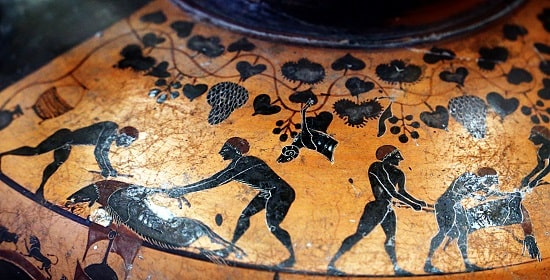
The sacrifice of animals, mainly cows, bulls, sheep, pigs, and goats, at the altars were very common in Ancient Greek religion. The greeks would say the prayers and hymns during the process of sacrifice.
The animals supposedly the best of their type were garlanded and paraded to the altar. Those animals were led by a young girl who would be with a basket on her head. The basket contained a hidden knife meant to sacrifice those animals.
Some ceremonies were done before the sacrificing ritual, and the blood of that animal was poured over the altars after the sacrifice. The internal organs and portions not meant for eating were burnt as the offering to the deity.
The edible meat was cooked for the attendees, while, the skin was kept for the temple to sell it to the tanners.
The belief behind the sacrifice was that the Greeks thought the animals would be happy to be sacrificed and led to numerous good consequences.
In some cases, mostly during simple and small offerings, greek farmers tossed grains on the sacred fire as the sacrifice. The grains sacrificed were the part of the first fruits collected by them.
Similary, on some places, fluid pouring was also common. Mostly wine, honey, and olive oil was used at the altars.
Other fluids, such as olive oil and honey, may make more formal ones for temple altars.
Temples and Sanctuaries of Ancient Greece
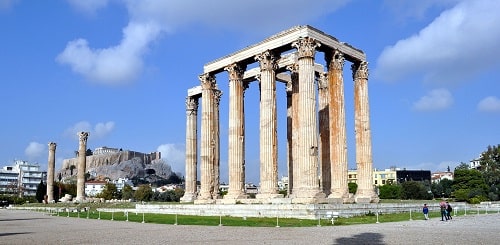
The temples in Ancient Greek were built enclosed with a fence while the entire area was known as the sanctuary. Acropolis in City of Athens was the most known temple ever built in Ancient Greece.
A proper sanctuary in Ancient Greece had a Tenemos which was placed at the center and around it were rocks, caves, groves, or springs.
The temples were meant for the prayers and worshipping. While, the sacrificing process were done outside of the temples, mostly at the altars.
However, with evolving time and modification of the temples, both interior and exterior of the temples had sculptures, shrines, paintings, military trophies, metals, and statues that made temples more like the museum.
Each temple was dedicated to a particular deity and it contained statues, paintings, images and depictions of that deity. The main attraction of the temple was the cult of the deity which was made bigger than the real life size.
The cult were made using marble, wood, precious metals, or terracotta. Some parts of the cult was embodied with gold.
They once considered that only priests had access to a Greek temple’s cella, which ordinary guests only visited on rare occasions, during ceremonies, and festivals.
Role of Greek Women from the religious aspect
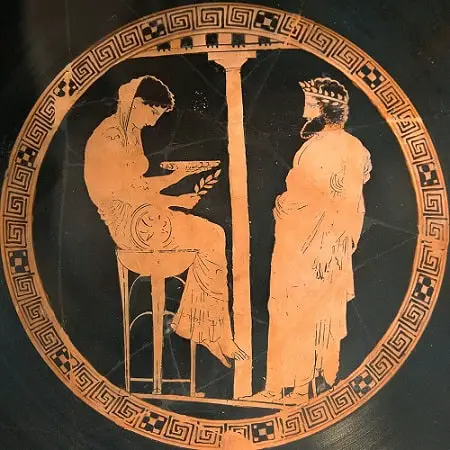
Greek religion had place for the Priestesses who would acquire some social status and greater luxuries.
They were mainly from local aristocratic families; some posts needed virgins, who would typically only serve for one year or two before marrying, while married women filled others.
Women who became priestesses voluntarily were respected by the people and their bodies, after death, were buried in a public location to show respect.
The women interested to become the priestesses had to be in proper health with sound mind. It was as the Greeks believed that the person serving the deity had to be in similar state as the deity himself/herself.
Like the priest and priestesses, religious holidays also differed based on the gender. For instance, Adonia, Plerosia, and Skira were the festivals meant only for the women.
The decline of Greek religion and their belief in gods
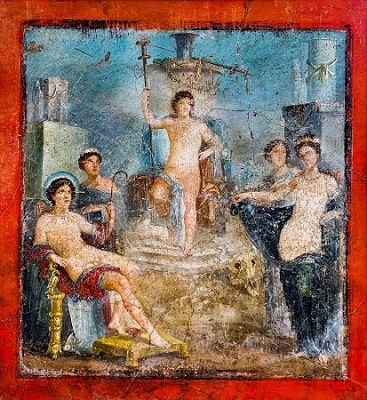
The syncretic aspect of Greco-Roman polytheism, which assimilated ideas and practices from a range of foreign religious traditions as the Roman Empire expanded, contributed to its initial downfall.
Mystery religions like Christianity and Mithraism grew popular as Greco-Roman philosophical schools combined parts of Judaism and Early Christianity.
Constantine I was the very first Roman Emperor to convert to Christianity.
Newly converted Christians did not just continue worshiping in converted temples, contrary to some earlier studies; instead, new Christian communities arose when previous pagan communities deteriorated and were finally persecuted and liquidated.
Julian pursued a strategy of marginalization but not destruction towards the Church, tolerating and offering governmental support to other prominent faiths (especially Judaism) when he considered doing so would undermine Christianity.
Julian’s successor Constantinus revoked parts of Julian’s reforms, while Jovian, Valentinian I, and Valens carried on Julian’s policy of religious tolerance inside the Empire, earning praise from pagan writers.
Theodosius vigorously implemented anti-pagan laws, disbanded priesthoods, demolished temples, and actively participated in Christian efforts against pagan holy sites.
He passed laws prohibiting pagan deity worship not just in public but also in private households.
Despite the Roman government’s official repression, worship of the Greco-Roman gods lingered throughout the early Middle Ages in some rural and distant areas.
At Monte Cassino, a supposed temple to Apollo with a community of worshipers and a holy grove persisted until 529 AD, when Saint Benedict of Nursia forcibly turned it to a Christian church, destroying the altar and cutting down the forest.
More lately, a renaissance of contemporary Hellenism, as it is also known, has begun. Hellenic Ethnic Religion is the word used in Greece.
Modern Hellenism reflects Neoplatonic and Platonic thought and classical cult practice (as depicted by Porphyry, Libanius, Proclus, and Julian).
However, compared to Greek Orthodox Christianity, it has a far smaller following.
Conclusion
Many gods were worshiped by the ancient Greeks, each having his personality and territory. Greek mythology explained the gods’ origins and unique relationships with humankind.
Many mythical incidents are shown in Archaic and Classical Greek art, including an established iconography of traits that distinguish each god.
Ancient Greek religious practice was founded on time-honored observances dating back to the Bronze Age (3000–1050 B.C.) or even earlier.
The concept of exchange: gods and goddesses were expected to deliver gifts built the human-divine interaction.
Individual worshippers’ physical expressions of thankfulness were votive offerings, which thousands have discovered from sanctuaries.
The Greeks worshiped in sanctuaries that were either within the city or in the countryside, depending on the nature of the deity.
A sanctuary was a well-defined sacred location separated from the rest of the world by a wall.
Animal sacrifice, particularly oxen, goats, and sheep, was a central religious rite in ancient Greece.
Sacrifices were performed within the sanctuary, usually on an altar in front of the temple, with the assembled participants eating the victim’s guts and meat.
Liquid offerings, often known as libations, were also prevalent. Religious festivals, or feast days, were held throughout the year.
